There can be your advertisement
300x150
Dream Bathroom on a Reasonable Budget
Secret tips used by designers in their projects
In the ranking of most expensive rooms for renovation, the bathroom confidently occupies second place after the kitchen. The cost per square meter here can reach sky-high figures—specialized finishing, complex communications, plumbing, and the need for waterproofing quickly turn the budget into a frightening sum. In 2025, a full renovation of even a small bathroom can cost from 350,000 to 500,000 rubles. But what if the potential for reasonable savings is hidden precisely in this room? Professional interior designers know the secrets of creating a stylish and functional bathroom without extravagant expenses—and they use these techniques in their own homes.
Main points from the article:
Designers save up to 35% of the bathroom renovation budget by using five key zoning and finishing techniques;
The most overvalued elements are expensive designer tiles for all surfaces and premium-class storage systems;
Smart budget distribution with emphasis on quality plumbing and waterproofing, not expensive finishing materials;
Combining budget and premium materials according to the principle of "accent zones" creates a high-end look;
Modern alternatives to tiles can reduce costs by 25-40% without losing quality or visual appeal.
Mistakes that inflate the budget: how to avoid them
Before revealing the secrets of saving, it's important to understand typical mistakes that turn bathroom renovation into an unpredictable financial adventure:
Mistake #1: "Tiles from floor to ceiling"
The traditional approach assumes tiling all surfaces with ceramic tiles. This is not only the most expensive option for finishing (especially when accounting for labor costs), but also not always practical. Modern water-resistant paints, panels, and other materials are often cheaper, faster to install, and just as visually impressive.
Mistake #2: Chasing perfect symmetry
Striving for perfect symmetry and matching tiles "by pattern" significantly increases waste (up to 20-25%) and raises labor costs. The visual effect of such meticulousness is often imperceptible to the untrained eye.
Mistake #3: Standard solutions for non-standard spaces
Standard furniture and plumbing sets rarely fit perfectly into a specific space. The result is unused "dead zones" and irrational space organization, forcing compromises in functionality or the need to buy more expensive equipment.
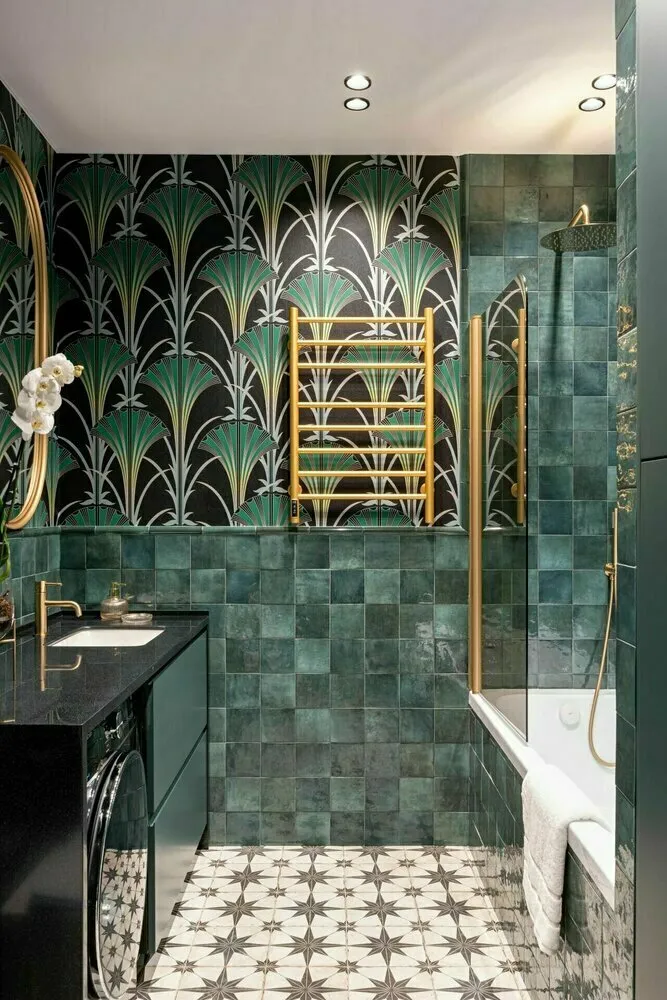
Design: Viktoria Shapovalova
Secret techniques of professionals: what works in practice
Secret #1: 70/30 rule for distributing finishing materials
Professional designers rarely use expensive tiles or finishes on all surfaces. Instead, they apply the "70/30" principle:
- 70% of surfaces are decorated using quality but affordable materials (basic tiles, water-resistant paint);
- 30% is reserved for accent zones using expensive and impressive materials.
"In my bathroom, I use simple white large-format tiles for main surfaces, and the area near the sink and the shower niche are tiled with mosaic that really creates a wow effect. In the end, I save about 40% on materials, but visually the room looks premium," - many designers use this strategy.
Secret #2: Large-format materials instead of small elements
Small tiles and mosaics not only cost more but also significantly increase labor time for installation. Designers in their homes often use large-format ceramic granite measuring 60×60 cm or even 60×120 cm.
Advantages:
- Fewer joints - easier cleaning and fewer issues with mold;
- Fast installation - labor cost savings up to 30%;
- Modern look - large formats create a sense of spaciousness;
- Less grout and adhesive consumption.
Large format visually "opens up" the space, making even a small bathroom room appear more spacious.
Secret #3: Alternatives to traditional tiles
The modern market offers many alternatives to classic ceramic tiles, which designers themselves use:
- Ceramic granite in natural stone look - looks like marble or granite but costs 50-70% less;
- WPC panels with embossing - waterproof, quick installation, visually indistinguishable from tiles in areas without direct water contact;
- Microcement - seamless coating that creates a loft or concrete effect, costs 15-20% less when professionally applied;
- Glass panels with photo printing - for accent walls, create depth and volume.
"In the toilet zone and above the sink, I use premium-grade water-resistant paint instead of tiles. This saves 70% in material and labor costs, and looks modern and stylish," - designers admit.
Secret #4: Functional plumbing without paying premium prices for brands
Different from finishing materials, designers don't recommend cutting corners on plumbing quality. However, they know how to avoid overpaying for famous brands:
- Mid-range manufacturers often offer models that are visually and functionally not inferior to premium brands;
- Many European brands have budget lines produced in the same factories as their premium products;
- Faucets made from solid brass without chrome plating (black, matte, bronze) often last longer than shiny chrome-plated analogs;
- Some elements (drain pipes, water supply hoses) can be chosen from the basic segment—they are hidden and do not affect appearance.
"I never skimp on faucets, toilets, and installation systems. These are the heart of a bathroom room. But this doesn't mean I choose the most expensive brands—I choose the optimal price-quality combination," - this approach is common among professionals.
Secret #5: Proper lighting as a tool for transformation
- Well-planned lighting can completely transform even the most budget-friendly bathroom room, and designers actively use this:
- Multi-level lighting (general light + accent + functional) creates depth and volume;
- LED mirror backlighting is not only functional but also visually expands the space;
- Properly chosen light color temperature (3000-4000K) makes any material more attractive;
- Spotlights directed at accent surfaces highlight the texture and surface of materials.
"In my bathroom, I have regular spotlights, but they are positioned to account for all zones and reflective surfaces. This creates a feeling of expensive lighting design without major investments," - specialists share their experience.

Design: Milada Ayzeman
Three zones where you can't save
With a limited budget, it's crucial to set priorities correctly. According to professionals, there are three aspects where economy is inappropriate:
Zone #1: Waterproofing
High-quality waterproofing is the foundation of a reliable bathroom room. Cutting corners here can lead to leaks to neighbors and expensive repairs not only for you but also for the floor below.
This means:
- Using tested waterproofing compounds;
- Careful treatment of complex areas (wall and floor joints, communication entry points);
- Professional work execution following the technology.
Zone #2: Installation system for suspended plumbing
If you choose a suspended toilet or bidet, economy in the installation system is unacceptable. This hidden element is extremely difficult to access after renovation completion.
Designers recommend choosing systems from proven manufacturers with long-term warranties and availability of spare parts on the Russian market.
Zone #3: Faucets and shower system
Faucets are elements you interact with daily. Budget models quickly fail and can become sources of problems from leaks to unpleasant noise.
However, quality faucets don't necessarily have to be from the most expensive brands—what matters is the materials used (solid brass body, ceramic cartridges) and build quality.
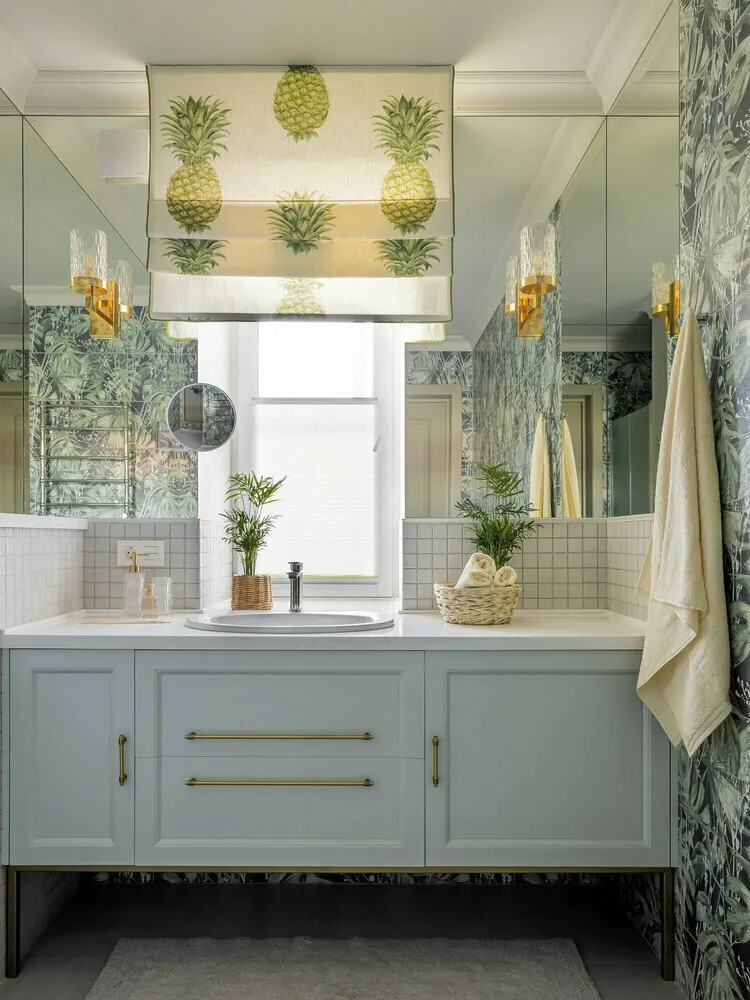
Design: Liliya Asfandiyaрова
Designer tricks for visual transformation
Trick #1: Partial finishing instead of full
Instead of tiling walls to the ceiling, designers often use a combined approach:
- Tiles in high-moisture zones (around bathtub, shower, sink);
- Water-resistant paint or decorative plaster for other surfaces.
This approach not only reduces material and labor costs but also makes the space visually more interesting than monotonous tile cladding.
Trick #2: The effect of built-in furniture without custom solutions
Custom-built furniture costs a lot. Designers often use a simple trick:
- Standard wall-mounted cabinets are installed right next to each other;
- Decorative panels in matching color are placed between cabinets and walls;
- A single cornice or strip on top unifies the composition.
As a result, a feeling of one integrated built-in structure is created, although standard modules were used.
Trick #3: Glass partitions instead of cabins
For small bathrooms, designers often recommend abandoning enclosed shower cabins in favor of glass partitions:
- Visually the space appears more spacious;
- The cost of a simple glass partition is lower than a full cabin;
- This solution looks more modern and premium.
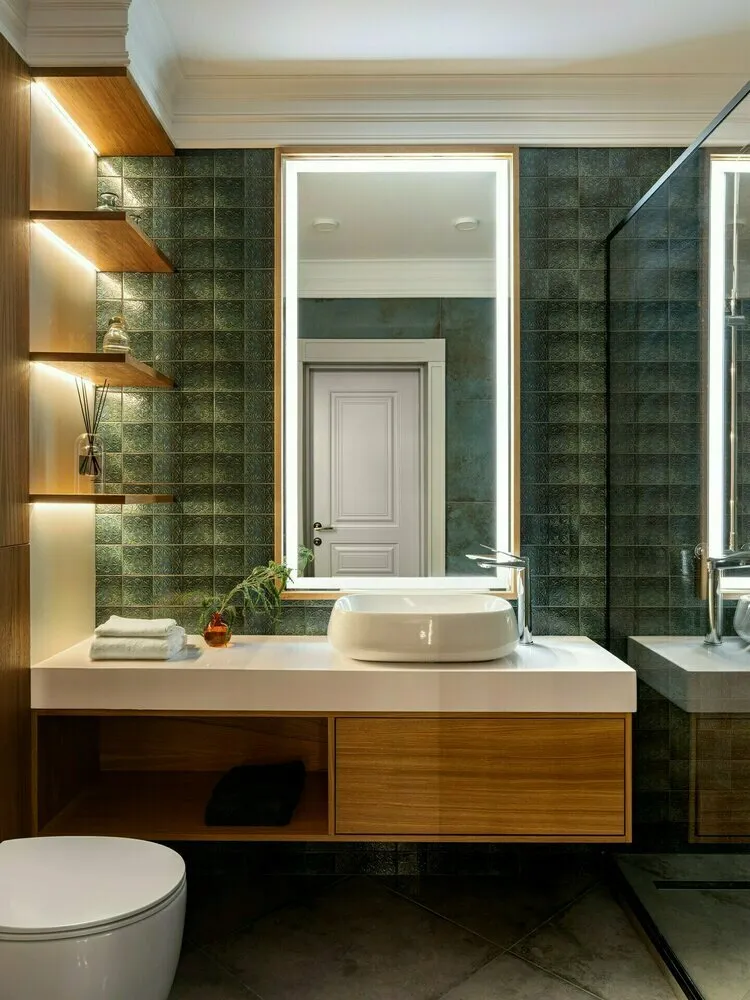
Design: Yana Ukhova
Practical action plan: how to implement designer techniques
Step 1: Analysis and planning
Start with detailed planning and creating a comprehensive estimate:
- Determine functional zones and their priorities;
- Compile a list of required communications and their placement;
- Calculate the necessary amount of materials with a 10-15% buffer.
Step 2: Focus on engineering systems
- First address the plumbing and electrical layout;
- Pay special attention to waterproofing;
- Plan ventilation—often overlooked but critically important aspect.
Step 3: Reasonable choice of finishing materials
- Determine accent zones that will be in the focus of attention;
- For main surfaces, choose neutral and universal materials;
- Follow the 70/30 rule when distributing the budget for finishing.
Step 4: Plumbing and furniture
- Choose plumbing focusing on price-quality ratio, not just brand;
- Consider ready-made modular storage solutions;
- Focus on functionality—convenience of use is more important than appearance.
Step 5: Lighting and finishing touches
- Plan multi-level lighting;
- Add mirrors to visually expand the space;
- Choose a unified style for accessories (holders, hooks, towel warmers).
Modern solutions for 2025 to save budget
In 2025, new solutions appeared on the market that designers actively use to create stylish bathrooms with limited budgets:
Next-generation composite panels
Ultra-thin (from 3 mm) waterproof panels with the texture of natural stone are installed without joints and look like expensive stone surfaces. Their cost is 40-60% lower than natural stone or large-format ceramic granite.
Smart faucets without "smart home" dependency
New affordable models of faucets with built-in temperature and water flow sensors help save up to 30% on water without connecting to complex "smart home" systems. These devices pay for themselves in 1.5-2 years just from utility savings.
Modular storage systems with expansion capability
Manufacturers offer basic storage systems that can be gradually expanded with modules. This allows spreading costs over time and adapting the system to changing needs.
The bathroom room is a blend of technical complexity and aesthetics, functionality, and comfort. Following the secret techniques of professional designers, you can create a space that will delight you for years without breaking your family budget. The key is setting the right priorities and not chasing trendy fads at the expense of quality basic elements. Because designers know: a truly successful interior design is not the one that impresses in photos, but the one that remains functional and attractive for years to come.
Cover: Design project by Inna Velichko
More articles:
 5 super solutions for relaxing on the balcony
5 super solutions for relaxing on the balcony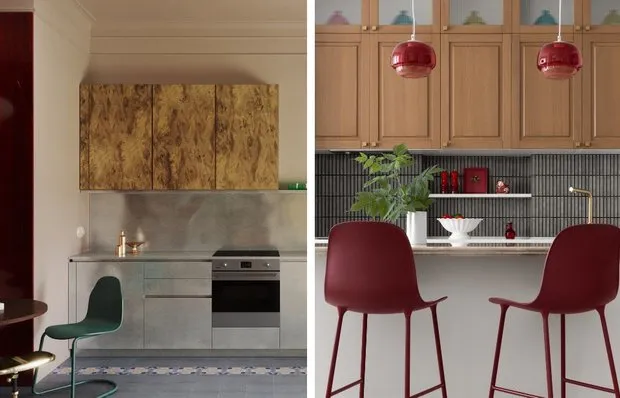 6 Ideas for Kitchen Apron Design That You'll Want to Implement
6 Ideas for Kitchen Apron Design That You'll Want to Implement Bathrooms in Old-Style Buildings: 5 Successful Examples
Bathrooms in Old-Style Buildings: 5 Successful Examples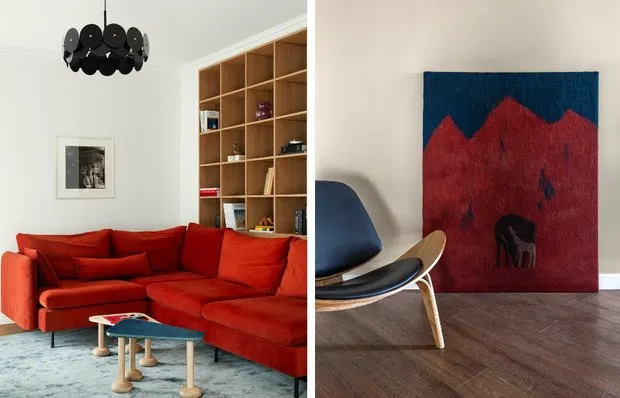 How to Fight Dust in Apartment: 11 Working Tips
How to Fight Dust in Apartment: 11 Working Tips Before and After: How to Transform a Dead Apartment into Your Dream Interior
Before and After: How to Transform a Dead Apartment into Your Dream Interior How We Designed a Cozy Hallway in an 18th Century Mansion
How We Designed a Cozy Hallway in an 18th Century Mansion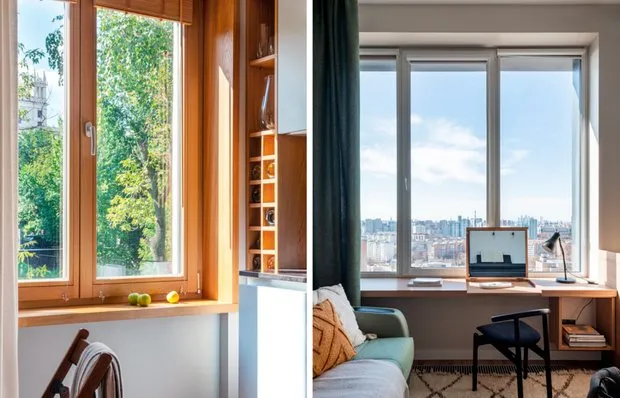 How to Beautifully and Practical Decorate a Windowsill: 8 Successful Ideas
How to Beautifully and Practical Decorate a Windowsill: 8 Successful Ideas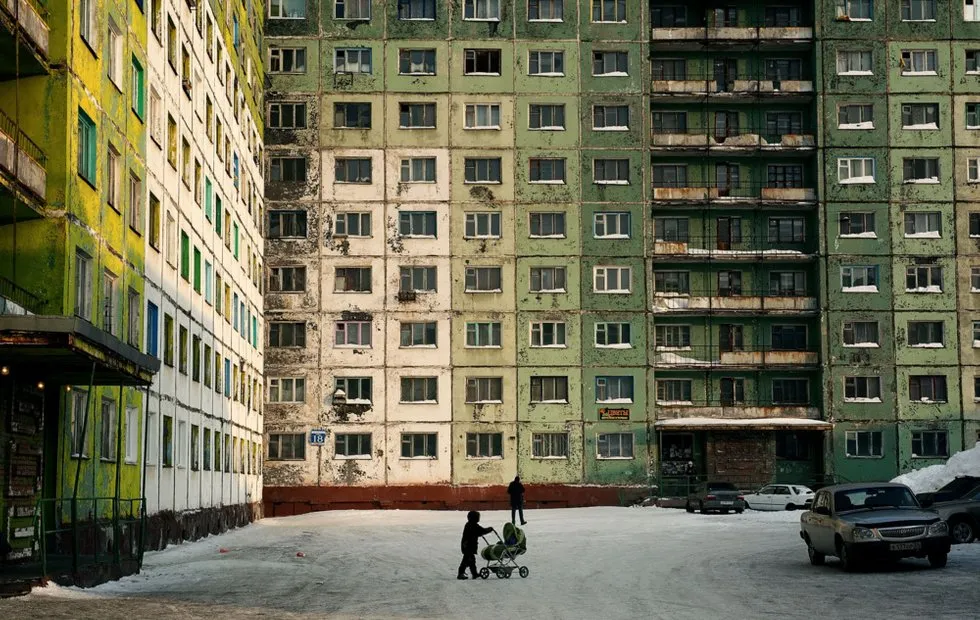 9 Floors of Soviet Pragmatism: Why the USSR Massively Built Nine-Story Buildings
9 Floors of Soviet Pragmatism: Why the USSR Massively Built Nine-Story Buildings